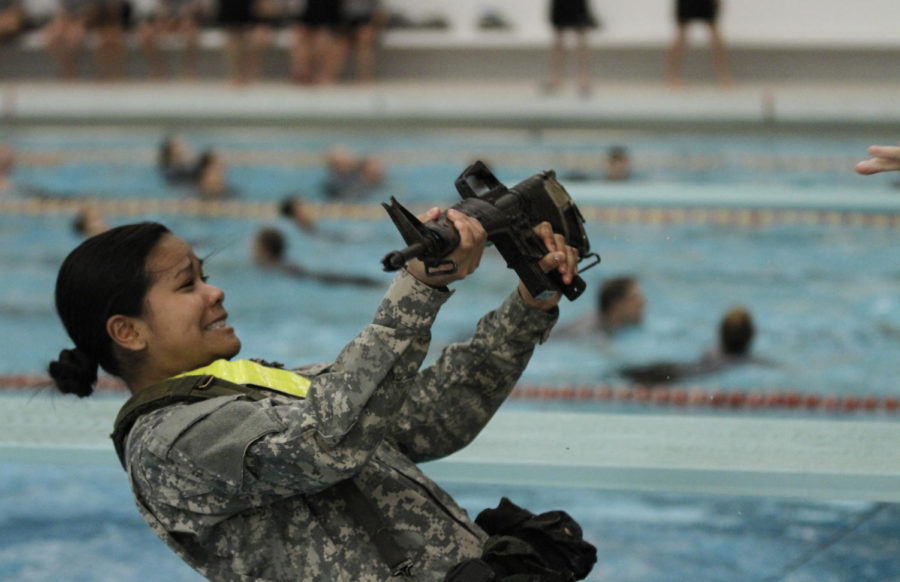Making a splash: Army ROTC cadets build confidence
Tiffany Herring/Iowa State Daily
Kristine McCunn is thrown in the pool in with full gear and a gun during Combat Water Survival Training Lab on Feb. 19 at Beyer Pool. The training lab is meant to help officers prepare for water related and high stress situations.
February 20, 2014
On Feb. 19, approximately 120 ISU Army ROTC cadets jumped into the Beyer Hall pool for the bi-annual Combat Water Survival Training Lab. Cadets rotated through five stations to prove their ability in the water.
Anthony Stoll, officer in charge and senior cadet, said, “The whole focus around this lab is to test our confidence and our ability to handle ourselves within a stressful situation.”
Senior cadets facilitate the lab while all the underclassmen cadets participate.
The lab consists of a swim diagnostic test, which has two stations — a 10-minute continuous swim, as well as a 5-minute water tread.
In both stations, the cadets were not allowed to have their feet touch the bottom of the pool.
In the continuous swim station, the cadets had to swim around the edges of the lane while keeping their head above the water for 10 minutes.
Dan Saladin, a sophomore cadet, said that the hardest part of the lab for him was the 10-minute continuous swim.
In another lane, the cadets had to tread water for five minutes while remaining stationary with their heads above the water.
There was also a lane for less-experienced swimmers. They could tread water in order to build more confidence in their swimming abilities.
For the survival training portion of the lab, cadets had three different stations.
The first was the gear-ditch station. Cadets, while in full uniform, had to dump their gear while submerged. Stoll said this adds 20-25 extra pounds to the cadet.
Cadets then jumped into the water with their uniform, a load-bearing belt, as well as an M-16 plastic rifle. They then let go of their rifles, as well as pull off their belts before coming up to the surface. Cadets were given two attempts to successfully complete the station.
In the second station, the cadets had to complete a 15-meter swim with full gear. During this test, cadets had to keep their rifles above the water.
The final station consisted of the three-meter confidence test. Cadets were blindfolded and led to the edge of the three-meter diving board where they jumped off into the water.
“It’s a little scary because your eyes are covered up and you don’t know when you’re going to drop and fall a long ways,” said Anna Smith, sophomore cadet.
While some cadets are working to build their confidence in the water, other cadets look forward to the lab every semester.
Amber Jacobs, senior cadet, said, “I just loved it. It was my favorite lab.”
Raymond Kiemen, senior cadet, said the Combat Water Survival Training Lab is required by Cadet Command. All eight divisions across the United States are required to complete the lab.
Every cadet has a chance to retest a station as many times as time allows, if they fail the station.
Only junior cadets are required to pass the lab, as it is a prerequisite for the Leadership Development Assessment Course, said Stoll.
Stoll also said The LDAC is a 29-day course taken between junior and senior year that tests a cadet’s ability to lead. During LDAC, there is a water confidence course that elevates cadets 20-60 feet above water.
“This lab gives us confidence with our gear, confidence with swimming with our gear, confidence with swimming with weight, as well as swimming in water,” Stoll said.
Stoll also said he does not have the final numbers on how many cadets passed or failed the lab as of Feb. 19.







